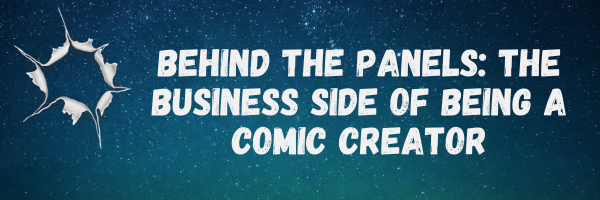
Behind the Panels: The Business Side of Being a Comic Creator
For many creators, comic creation is a passion project. But whether a person is creating as a hobby or looking to make a career out of it, comic creation is not cheap so it has to be approached like a business. To sustain this journey, it’s crucial to understand the investments involved, from hiring a talented team to managing production costs and distribution. In this month’s feature, we’ll dive into what it really takes on the business side of comics, including budgeting for team members, planning for print runs, and navigating convention logistics.
Building Your Dream Team: Hiring the Right Talent
Creating a high-quality comic is often a team effort. While some creators may handle multiple roles, many opt to hire specialists for certain tasks to bring their vision to life. Here’s a breakdown of key roles, what they bring to the table, and what to budget:
1. Artist: In my humble opinion, the artist is the MVP of the process. The artist breathes life into the script, transforming words into detailed illustrations. Artists often specialize in certain styles, so finding one that fits your story’s aesthetic is vital. Expect to pay between $50 to $200+ per page depending on the artist’s experience and reputation.
2. Colorist: A skilled colorist brings depth, mood, and energy to the art. Colorists generally charge between $30 to $80 per page. High-quality coloring is essential, as it can significantly impact how readers perceive the world within your comic.
3. Letterer: Good lettering is an often-overlooked element that helps guide readers through the story. Professional letterers may charge around $10 to $30 per page, depending on their expertise. Investing in a talented letterer ensures your story flows smoothly and looks polished.
4. Editor: An editor brings an outside perspective to the story, catches inconsistencies, and polishes dialogue. Some editors specialize in comics, understanding pacing and visual storytelling, which can be a significant asset. Depending on the editor’s level, fees can range from $500 to $2,000+ for an entire issue or project.
5. Cover Artist: The cover is your comic’s first impression. A skilled cover artist who understands eye-catching design will make a difference in sales. Cover art rates vary widely, from $150 to $600 or more for established artists.
Production Costs: Printing, Distribution, and Fulfillment
Once the team has created a finished comic, it’s time to think about production and logistics. Here’s what to consider for budgeting and planning:
1. Printing: Printing costs depend on the comic’s format, page count, paper quality, and print run size. For a standard 24-32 page color comic, printing costs can range from $1.50 to $4 per issue when ordering in bulk. For smaller print runs, expect higher per-issue costs. Research printing companies carefully, as quality and reliability vary widely.
2. Distribution and Shipping: Whether you’re selling directly to fans, through comic shops, or using a distributor, shipping logistics are a critical expense. For direct sales (like through a personal website or online shop), factor in packaging materials, postage, and fulfillment time. Many creators also list their comics on platforms like ComiXology or sell digital copies to reach a broader audience.
3. Convention Expenses: Conventions are fantastic for networking, selling comics, and building a fanbase, but they come with significant costs. Here’s a quick breakdown:
• Booth/Tables: Artist alley tables range from $100 to $500, while larger booths can cost $1,000+.
• Travel and Lodging: If you’re traveling, factor in airfare, hotel stays, and daily expenses.
• Merchandise and Display: To maximize your table’s appeal, you’ll want posters, banners, and possibly some extra merch like stickers or pins. Budget for about $300-$500 to set up a visually engaging booth.
Managing Finances and Logistics
As your comic project progresses, financial planning and logistics management become vital. Here are some essential strategies to stay organized and on budget:
1. Budget and Forecast: Track all expenses, and estimate your break-even point. Software like Excel, Google Sheets, or budget apps can help you categorize and monitor your spending.
2. Crowdfunding and Pre-orders: Crowdfunding platforms like Kickstarter are popular among indie creators, allowing you to raise funds upfront to cover production costs. By offering tiered rewards, you can attract backers at different price points. Many creators also use pre-orders to gauge demand and offset upfront printing costs.
3. Marketing and Networking: Factor in time and expenses for promoting your work, whether through social media ads, partnerships, or paid promotions on comic websites. Networking with other creators and attending conventions also offers invaluable exposure.
4. Logistics for Fulfillment: If you handle shipping yourself, invest in reliable packing materials and consider tools like Shopify or WooCommerce to streamline order management. For larger orders, some creators work with fulfillment companies to handle distribution professionally.
Final Thoughts
Comic creation is a journey with both creative and business challenges, but with the right team and a solid financial plan, your story can reach readers and generate income to support future projects.
Subscribe to the Portable Perspectives Newsletter for this and much more.
mailchi.mp/portableholepublishing/from-comics-to-ai-art-tips-reviews-and-more-12712509
